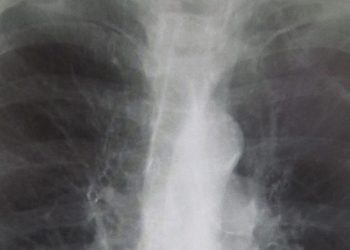Pediatric asthma associated with abnormal patterns of lung function growth and decline in adulthood: The CAMP Cohort
1. Childhood impairment of lung function and male sex significantly predicted abnormal lung-function patterns of growth and decline in adulthood.
2. Childhood persistent asthma and reduced lung function growth was associated with increased risk of fixed air flow obstruction and COPD in early adulthood.
Evidence Rating Level: 2 (Good)
Study Rundown: In healthy individuals, forced expiratory volume within one second (FEV1) typically peaks during adolescence. Lung function in adulthood may be predicted by the growth and decline patterns of childhood FEV1 – namely, with reduced growth predicting low level lung function, and early decline predicting chronic airflow obstruction. Few population-based epidemiologic studies evaluating outcomes of childhood asthma have used lung-function measurements in longitudinal assessments and few have addressed the effects of sex, age at onset and smoking in the outcome of these patients. In this study, researchers use data from the CAMP cohort (a pediatric asthmatic cohort, originally part of a randomized controlled trial for anti-inflammatory inhalants) and compared against healthy matched patients from the National Health and Nutrition Examination Survey (NHANES III) to evaluate the trajectory of FEV1 growth and decline from childhood to young adulthood. In general, researchers found that within the CAMP cohort – only 1/4 had normal lung-function without early decline, while the other 3/4 had abnormal patterns. Participants with reduced growth patterns, when compared to their healthy counterparts, had significantly lower than normal baseline FEV1 values, decreased bronchodilator response, more airway hyperresponsiveness at baseline and were younger and male.
Click to read the study, published today in NEJM
Relevant Reading: A longitudinal, population-based cohort study of childhood asthma followed to adulthood
In-Depth [retrospective cohort]: In this study, researchers used longitudinal data from CAMP and compared it against healthy matched patients from the NHANES III. Normal and reduced growth of lung function was determined by the 25%ile curve of NHANES values in FEV1, and early decline was defined as earlier-than-expected decrease on at least two data points from the maximal level of NHANES III data. For primary analysis, researchers grouped CAMP patients into two categories: normal lung-function without early decline (25%) versus abnormal patterns (75%). Within the abnormal patterns group, participants were categorized as either reduced growth and early decline (26%), reduced growth without early decline (23%) and normal growth with early decline (26%).
Overall, CAMP participants with a reduced pattern of growth were more likely to have COPD compared to their healthy NHANES counterparts (18% vs. 3%; p<0.001). Participants categorized as having reduced growth without early decline, when compared to control, were significantly more likely to have lower FEV1 at enrollment (OR=0.86/1% change in predicted value, p<0.001), lower bronchodilator response at baseline (OR=0.91/1% change, p<0.001), greater airway hyperresponsiveness at baseline (OR=0.61/unit change in log-transformed mg/mL, p<0.001) and more likely to be male (OR=8.18, p<0.001) and younger at enrollment (OR=0.55/year of age, p<0.001). Reduced growth and early decline compared to those with normal growth was similarly associated with significantly lower FEV1 (OR=0.86/1% change in predicted value, p<0.001), lower bronchodilator response (OR=0.91/1% change, p<0.001) and increased airway hyperresponsiveness (OR=0.66/unit change in log-transformed mg/mL; p=0.008) and were also more likely to be male (OR=3.07;p<0.001) and younger at enrollment (OR=0.62 per year of age; p<0.001).
Image: PD
©2016 2 Minute Medicine, Inc. All rights reserved. No works may be reproduced without expressed written consent from 2 Minute Medicine, Inc. Inquire about licensing here. No article should be construed as medical advice and is not intended as such by the authors or by 2 Minute Medicine, Inc.






